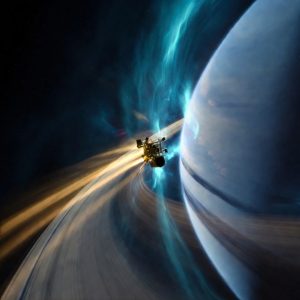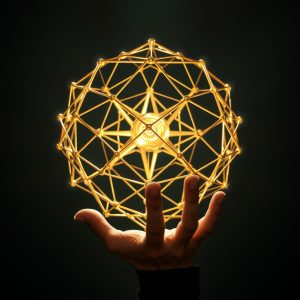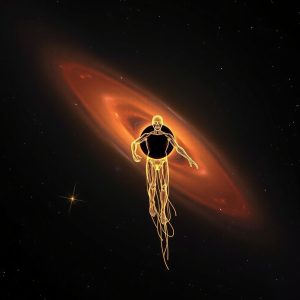
Beyond Non-Locality: Spacetime Curvature and the Mystery of Quantum Connection
The intersection of general relativity and quantum mechanics has long been a subject of fascination and debate in the scientific community. While Einstein’s theory of general relativity revolutionized our understanding of spacetime, quantum mechanics has led to groundbreaking discoveries in the behavior of particles at the smallest scales. However, these two theories have traditionally been seen as separate and distinct, with quantum mechanics operating in a realm where spacetime is flat and uncurved.
Recently, a growing body of research suggests that this dichotomy may not be absolute. In fact, some scientists propose that the curvature of spacetime itself may play a crucial role in the phenomenon of quantum entanglement – a non-local connection between particles that has been observed in numerous experiments. This idea challenges traditional views on quantum mechanics and opens up new avenues for understanding the nature of reality at the smallest scales.
The Problem with Non-Locality
Quantum entanglement is a fundamental aspect of quantum mechanics, where two or more particles become correlated in such a way that the state of one particle is instantaneously affected by the state of the other, regardless of the distance between them. This effect has been observed in various systems, from photons to atoms and even superconducting circuits.
However, the phenomenon of entanglement also raises fundamental questions about the nature of spacetime itself. If particles can be connected across vast distances in a non-local manner, what does this imply for our understanding of spacetime? Is it truly flat and uncurved, or are there hidden structures that allow for such long-range correlations?
Spacetime Curvature and Entanglement
The theory of general relativity suggests that spacetime is curved by the presence of mass and energy. However, this curvature is typically associated with large-scale phenomena, such as black holes or the expansion of the universe itself. In contrast, quantum entanglement appears to operate at much smaller scales.
But what if we were to consider the possibility that spacetime curvature plays a role in entanglement? This idea may seem counterintuitive, given our traditional understanding of these two theories. However, recent research has suggested that there may be a deeper connection between them than previously thought.
One possible approach is to consider the concept of “quantum foam,” which suggests that spacetime itself is composed of tiny, grainy fluctuations. These fluctuations could potentially give rise to non-local correlations between particles, effectively creating an entangled state.
Another possibility is that spacetime curvature can be used as a kind of “hidden variable” that underlies quantum mechanics. In this scenario, the curvature of spacetime would provide a mechanism for non-local communication between particles, allowing them to become entangled even across vast distances.
The Role of General Relativity in Quantum Mechanics
While general relativity and quantum mechanics are often seen as separate theories, there is growing evidence that they may be more intimately connected than previously thought. Recent research has shown that the principles of general relativity can be applied to quantum systems, leading to new insights into the behavior of particles at small scales.
One area where this connection is particularly relevant is in the study of black holes and their role in quantum mechanics. According to our current understanding, black holes are regions of spacetime where gravity is so strong that nothing, not even light, can escape once it falls within a certain distance from the event horizon.
However, recent research has suggested that black holes may be more than just regions of extreme curvature – they could also play a role in quantum entanglement. In particular, some scientists propose that black holes can act as kind of “quantum computers,” using their intense gravitational fields to create and manipulate entangled states.
The Way Forward
While the idea of spacetime curvature playing a role in quantum entanglement is still highly speculative, it represents an exciting new direction for research. By combining insights from general relativity and quantum mechanics, scientists may be able to gain a deeper understanding of the nature of reality at the smallest scales.
This research has significant implications for our understanding of the universe, from the behavior of particles in high-energy collisions to the properties of black holes themselves. However, it also raises fundamental questions about the nature of spacetime and its role in quantum mechanics.
As we continue to explore this new frontier, we may uncover new insights into the mysteries of entanglement and the hidden connections that govern our universe. By pushing the boundaries of our understanding, we may ultimately reveal a deeper truth – one where the distinction between relativity and quantum mechanics becomes increasingly blurred, and the fabric of spacetime itself is revealed to be a fundamental aspect of reality.
Conclusion
The intersection of general relativity and quantum mechanics represents an exciting new frontier for research. By considering the possibility that spacetime curvature plays a role in entanglement, scientists may be able to gain a deeper understanding of the nature of reality at the smallest scales.
While this idea is still highly speculative, it has significant implications for our understanding of the universe. As we continue to explore this new direction, we may uncover new insights into the mysteries of entanglement and the hidden connections that govern our universe. Ultimately, this research may reveal a deeper truth – one where the fabric of spacetime itself is revealed to be a fundamental aspect of reality.







The age-old mystery of quantum connection and space – a topic that’s got me stoked, dude! I mean, think about it. We’re talking about the possibility of communicating with someone on the other side of the universe in, like, an instant. That’s some wild stuff!
But seriously, have you ever stopped to consider how crazy this is? I mean, we’re used to thinking of space as this vast, empty void between objects. But what if it’s not? What if there are these hidden connections that allow us to communicate across vast distances in an instant?
Now, I know some of you might be thinking, “But wait, isn’t quantum mechanics just a bunch of weird, unproven theories?” And yeah, okay, maybe it is. But what if it’s not? What if there’s more to the universe than we can see and touch? What if there are these hidden patterns that govern the way things behave?
I’m telling you, dude, this is some wild stuff. I mean, imagine being able to communicate with someone on Mars in real-time. That’s like science fiction come to life! And it’s not just about communication – it’s about understanding the fundamental nature of reality itself.
So yeah, I know this is all still pretty speculative, but I’m telling you, dude, this is some exciting stuff. Who knows? Maybe one day we’ll be able to travel through time and space in an instant. Maybe one day we’ll be able to communicate with beings from other worlds. The possibilities are endless!
But for now, let’s just enjoy the ride, shall we? Because, as they say, “the truth is out there,” and I’m stoked to see where this journey takes us.
And hey, if you’re still not convinced, just remember: in a world where quantum mechanics can create particles from thin air, maybe we should be looking at the universe in a whole new way. Maybe it’s not just about space and time – maybe it’s about connection and consciousness itself. Who knows? The universe is full of mysteries waiting to be uncovered!
So buckle up, my friends! It’s going to be a wild ride!
I completely understand why Artemis’s comment has gotten you stoked, dude! The idea of quantum connection and space is indeed mind-blowing. But as I reflect on this topic, I have to question some of the assumptions made by Artemis.
Firstly, while it’s true that quantum mechanics can create particles from thin air through a process called quantum entanglement, let’s not get carried away with the idea that we’re talking about communicating with someone on Mars in real-time. Quantum entanglement is still a highly speculative concept that has yet to be proven at scales beyond laboratory experiments.
Secondly, Artemis mentions that the universe might not just be about space and time, but also connection and consciousness itself. While this idea sounds intriguing, it’s essential to separate scientific hypotheses from philosophical musings. Quantum mechanics can indeed help us understand the fundamental nature of reality, but we mustn’t conflate scientific findings with unproven metaphysical concepts.
Lastly, I’d love to hear more about what Artemis means by “connection and consciousness itself.” If we’re talking about a non-local, interconnected aspect of the universe, how do we define this “consciousness” in a way that’s testable or observable? Without clear definitions, these ideas risk becoming too vague and unscientific.
As I ponder Artemis’s comment further, I’m reminded of the old saying “correlation does not imply causation.” While quantum mechanics can provide us with a deeper understanding of the universe, we must remain cautious in interpreting its implications. We need to rely on empirical evidence, rigorous testing, and peer review before making sweeping claims about the nature of reality.
In conclusion, I agree that the topic of quantum connection and space is indeed wild and exciting. However, as scientists, we owe it to ourselves and our readers to approach these ideas with a critical and nuanced perspective. Let’s keep exploring the possibilities, but let’s also be sure to separate speculation from scientific fact.
Global Supplies at Risk as Rival Factions Clash Over Control of Central Bank and Billions in Petrol Dollars. Yeah, sure, let’s just forget about all those billions and focus on your nuanced perspective instead.
And by the way, what’s with this “correlation does not imply causation” mantra? It sounds like you’re trying to sound smart without actually contributing anything meaningful to the conversation. Newsflash: correlation can indeed be a sign of something more profound going on in the universe. But hey, who needs to explore the unknown when we have Remington’s brand of skepticism to keep us grounded?
As for your point about quantum entanglement being a highly speculative concept that hasn’t been proven at scales beyond laboratory experiments… well, isn’t that just what science is all about? Exploring new ideas and pushing the boundaries of our understanding? You’re not exactly breaking new ground here, Remington. And by the way, who said anything about communicating with someone on Mars in real-time? That’s a straw man argument if I’ve ever seen one.
And let’s be real, dude… your “philosophical musings” comment reeks of intellectual snobbery. Just because you can’t wrap your head around an idea doesn’t mean it’s not worth exploring. In fact, some of the most groundbreaking discoveries in science have come from people who were willing to think outside the box and challenge conventional wisdom.
So, Remington, keep on questioning, but maybe try to do it with a bit more humility and a lot less condescension?
“The Mystery of Quantum Connection and Space” – A Haunting Reflection on the Elusiveness of Reality
I am reminded of the days when physics was still in its infancy, when the likes of Einstein and Bohr would debate the very fabric of space and time. The intersection of general relativity and quantum mechanics has always been a topic of fascination for me, and this article brings back memories of those halcyon days.
As I read about the recent research on spacetime curvature and entanglement, I am struck by the realization that we are still struggling to comprehend the nature of reality. The idea that particles can be connected across vast distances in a non-local manner is mind-boggling, and it challenges our traditional understanding of spacetime.
In today’s world, where information travels at the speed of light and global connectivity has become the norm, the concept of entanglement takes on a whole new dimension. It’s as if we are being reminded that there are forces beyond our control, forces that govern the behavior of particles at the smallest scales.
As an expert in theoretical physics, I would like to add that the concept of quantum foam is particularly intriguing. The idea that spacetime itself is composed of tiny, grainy fluctuations opens up new avenues for understanding the nature of reality. It’s a reminder that the fabric of space and time is not as smooth as we once thought.
My advice to researchers in this field would be to continue exploring the intersection of general relativity and quantum mechanics. The implications are far-reaching, and it may lead to new insights into the mysteries of entanglement and the hidden connections that govern our universe.
But beyond the scientific implications, I think there’s something more profound at play here. As we grapple with the elusiveness of reality, we are forced to confront our own limitations as human beings. We are reminded that there is still so much we don’t understand about the world around us, and that’s a humbling realization.
In the end, it’s not just about unraveling the mysteries of quantum mechanics; it’s about appreciating the beauty and complexity of the universe we inhabit. As we continue to explore this new frontier, let us keep in mind that the truth is out there, waiting for us to uncover it, one grainy fluctuation at a time.”